You have probably seen a picture of a smiling dolphin with a mouth full of pearly white teeth. Dolphins are whales but not all whales have teeth. When it comes to whales, teeth are what set them apart. The two groups of the order Cetacea (Whales) are the baleen whales and the toothed whales.
If you guessed the toothed whales are the ones with teeth you would be right. Baleen whales have baleen which are longs hair-like follicles that act as a sieve for food in the ocean. Baleen whales live off of small fish, krill and plankton and do not need teeth. Most toothed whales actively hunt their prey and need teeth to catch and/or chew their food (some species swallow their food whole). Unlike sharks that have rows and rows of teeth that are easily replaced, most whales are like humans and have one set of teeth that if they lose one they do not grow back, although I have never seen a dolphin with dentures.
Sperm whale teeth: The largest teeth of any whale
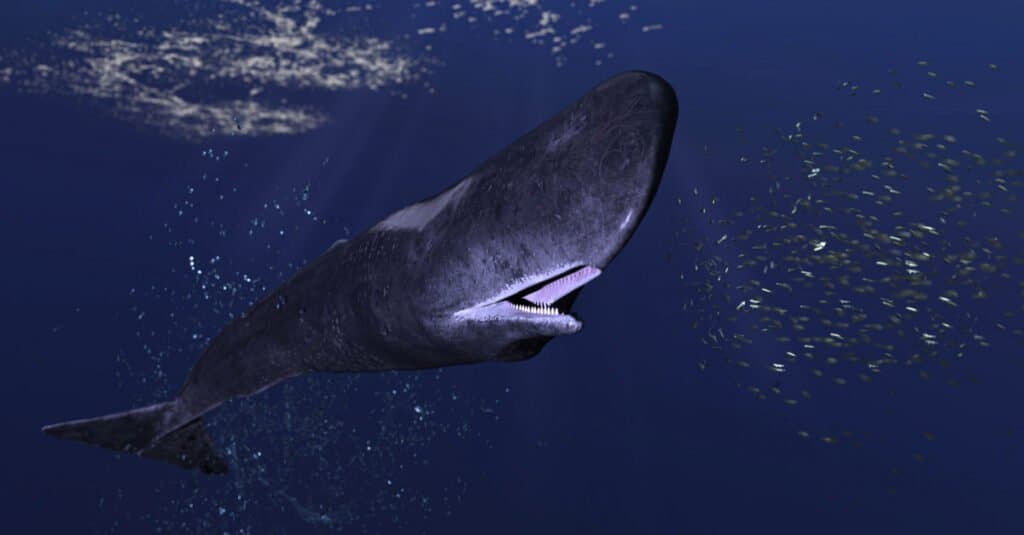
A sperm whale with an open mouth showing off its massive teeth
©bekirevren/Shutterstock.com
The sperm whale has the largest teeth of any whale species. Sperm whales only have teeth on their lower jaw — their upper jaw has sockets for teeth to rest in – and their teeth can reach incredible lengths. Sperm whale teeth can measure 4 to 8 inches and weigh up to 2.2 pounds (1 kilogram). For perspective, most modern great white shark teeth don’t exceed much more than about 2.5 inches in length. That makes sperm whale teeth more than 3 times the length of the largest modern shark!
Sperm whales use these massive teeth for hunting squid during deep sea dives. The deepest recorded sperm whale dive was nearly 10,000 feet, where they hunt for deepwater species like giant squid, sharks, and rays. Their large teeth are necessary for catching squid that can reach more than 40 feet in length with their tenticles!
Believe it or not, but ancient sperm whales had even larger teeth! A sperm whale relative named Livyatan that lived 5 million years ago had teeth that measured 14 inches in length! That gives Livyatan the largest biting teeth of any known animal.
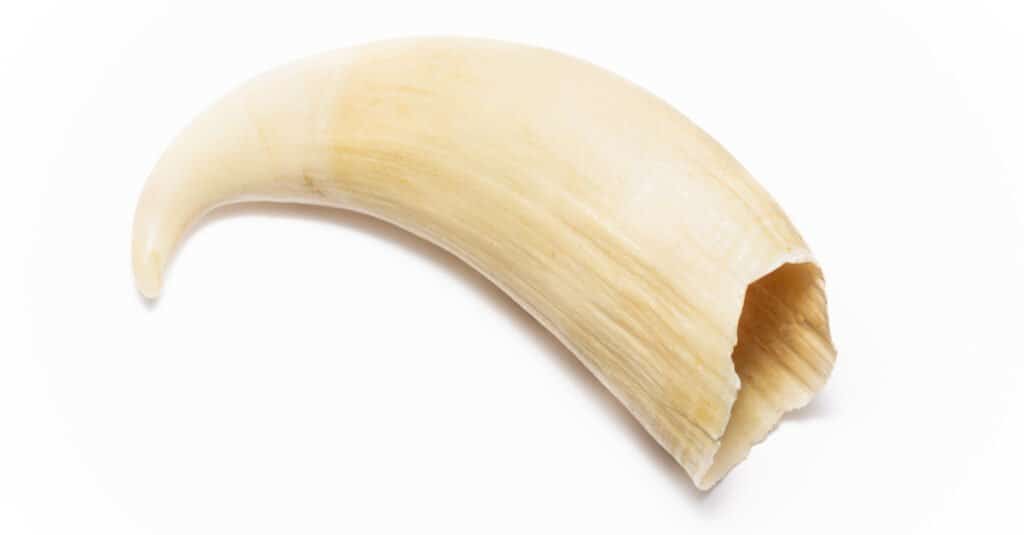
The tooth of a sperm whale
©Steven Giles/Shutterstock.com
What kinds of whales don’t have teeth?
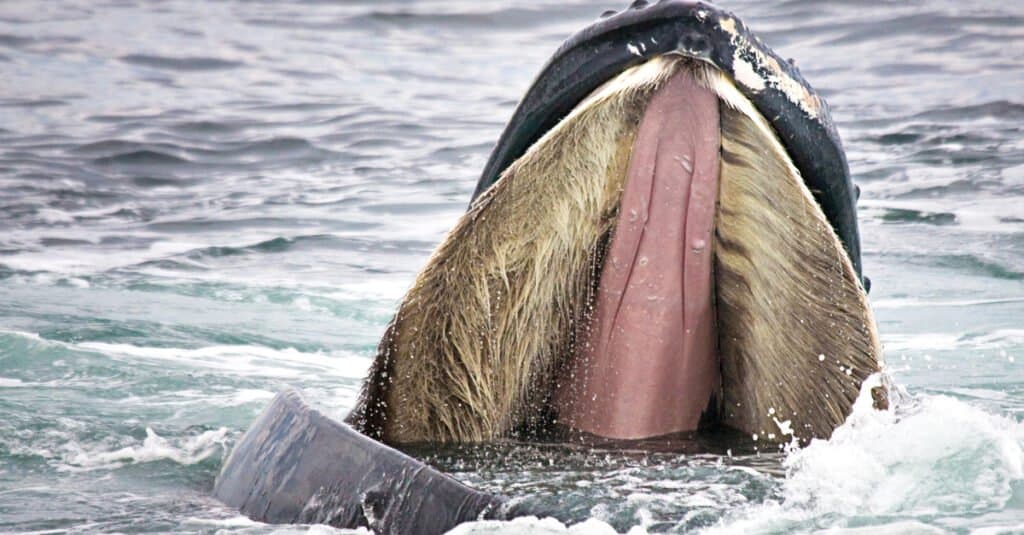
A closer look at baleen inside a whale’s mouth
©John Tunney/Shutterstock.com
All baleen whales, mentioned earlier, do not have teeth. They use their baleen to sieve through the ocean locating small schools of fish and plankton to fill them up. Baleen whales include the largest living animal the blue whale as well as fin, sei, humpback, right, pygmy right and gray whales. The bowhead whale has the longest baleen coming in at 13 feet long. Good thing they don’t need to brush that would be quite the bedtime ritual!
How many teeth do dolphins have?
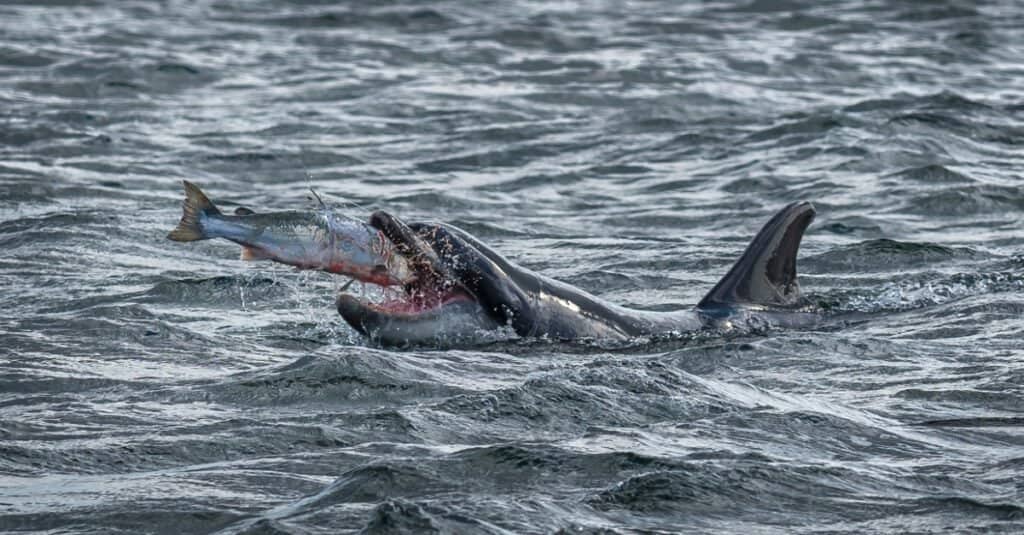
A dolphin catching dinner!
©iStock.com/grafxart8888
There are 32 species of dolphins with some variations in their dental structures, but most commonly they have 72-104 teeth. Bottlenose dolphins have teeth that are sharp and pointed but they do not use them to chew. They do use their beaks and teeth to snatch and catch prey like fish, crabs, shrimp and squid and then they swallow it whole. I can see swallowing a squid would be easy, but a spikey fish? They have skills for that, they know to grab the fish with their teeth and swallow it head first so that their spikes don’t cut them on the way down.
Killer Whale Teeth: Bigger Than a Great White!

A killer whale showing off its teeth
©Heather Renee/Shutterstock.com
Killer whales are actually a type of dolphin. Killer whales are the biggest dolphin species and are black and white and can grow to be 32 feet long! You would assume a big whale like that would have big teeth and you would be right!
A killer whale tooth is up to 4 inches long and 1 inch in diameter. Now that is a big tooth that exceeds great white shark tooth sizes (which are normally around 2.5 inches in length) . Killer whales have 40-56 white teeth that are interlocking top to bottom. They only have one set of teeth and cannot regrow teeth. Killer whales are vicious hunters and hunt in groups and use their teeth to attack their prey, but after tearing their prey into pieces they swallow their prey whole. There are some killer whale groups that prefer to eat fish, like salmon, and another group that prefers marine mammals like sea lions, walrus and seals.
How are dolphin and porpoise teeth different?

The biggest difference between dolphins and porpoises is that dolphins have a long beak (or snout) and porpoises have a rounded face with little or no beak. Dolphins are also bigger than porpoises. There is one species of porpoises that does not have a dorsal fin (Yangtze Finless Porpoise) whereas all dolphins have dorsal fins. Another difference is that dolphins have triangular, pointed teeth and porpoises have flatter or spade-shaped teeth. Porpoises do not use their teeth to chew and like the dolphins, they eat their prey whole and enjoy fish, crustaceans and squid.
What kind of whale has only one tooth?
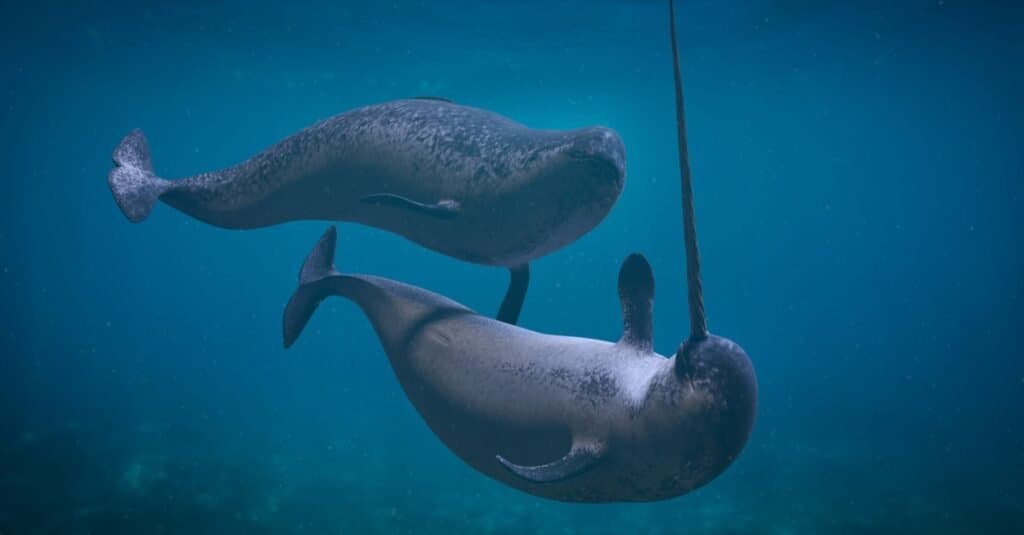
A Narwhal couple, two Monodon monoceros playing in the ocean.
©iStock.com/dottedhippo
One of the most unique looking whales only has one tooth. The narwhal has what appears to be a unicorn horn coming out of its head. It is actually a tooth made from similar compositions of tusks but has very different properties. The long tusk-like tooth spirals and comes to a point. The ends of the tooth are flexible enough to bend perhaps to prevent breakage. The outer part of the tooth is porous and the inner part is more similar to our dentine.
One research study compared the properties of narwhal tooth to that of human teeth, cattle teeth and reindeer antlers. The researchers found that the content and hardness of the narwhal tooth was “softer and less mineralized” than human and cattle teeth but that its flexible properties were more resemblance of reindeer antlers.
Not all narwhals have this horn-like tooth. Only the males will develop one with a few exceptions of females developing a smaller one that eventually fall off. Males will sometimes lose their tooth as well and seem to live fine without it. Some males will grow two teeth with one tooth being significantly smaller and rarely a male narwhal will grow two equally long teeth.
They do use their horn-like teeth to help with hunting but they do not use it to spear their prey like you may think. They may poke their prey to stun them and then lurch forward and swallow their prey. They do not have any other teeth and therefore swallow their prey whole.
What kind of whale has only two teeth?
Beaked whales only have two teeth! The Blainville beaked whale has two teeth, one on each side of their face that raise above their nose and look like small rhino horns. Because the teeth are exposed to the water and elements, barnacles often grow on them and make it look like they have star-shaped whiskers. (Maybe the beaked whales do need a dentist!).
Cuvier’s beaked whales only have two teeth as well but theirs are more concealed, just under their front snout. Only male’s teeth will be visible with the females having teeth but they never erupt. The teeth of beaked whales are not used for chewing food but instead are used to fight with other males during mating season.
The photo featured at the top of this post is © Heather Renee/Shutterstock.com
Thank you for reading! Have some feedback for us? Contact the AZ Animals editorial team.







